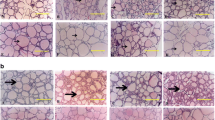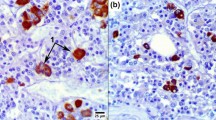Summary
The role of iodine in the formation of “cold” follicles (not labeled on autoradiograms after radioiodine administration) was analysed in ICR female mice during aging and involution of thyroid hyperplasia, by use of light and electron microscopy and by comparing autoradiographic and analytical ion-microscopic images for the same follicle in serial sections. The proportion of “cold” and “partly cold” (displaying a patchy or ring labeling pattern on autoradiograms) follicles increased significantly during aging. This increase was more pronounced in old mice fed an iodine-rich diet as compared to mice fed a moderate iodine diet. Similarly, during goiter involution produced by refeeding iodine, the follicular heterogeneity of iodine metabolism was more accentuated with a high dose of iodine, regardless of the age of the mice. The follicular lumina of “hot” and “cold” follicles had the same concentration of stable iodine, as shown by analytical ion microscopy, and the cells of both types of follicles formed colloid droplets in response to TSH. Furthermore, when a goitrogenic treatment was induced in aged mice, some “cold” follicles persisted after 8 days, but all follicles resumed “hot” after 16 days. By analytical ion microscopy, 127iodine was also found inside thyroid cells of old mice, but the cytoplasmic patches of 127iodine were not labeled with 125iodine. They corresponded to lipofuscin pigments and secondary lysosomes, as observed in serial sections at the electron-microscopic level. This intracellular stable iodine could constitute a slow turnover compartment not used for hormone synthesis.
Similar content being viewed by others
References
Bagchi N, Brown T, Shivers B, Mack RE (1977) Effect of inorganic iodide on thyroglobulin hydrolysis in cultured thyroid glands. Endocrinology 100:1002–1007
Burns MS (1988) Biological microanalysis by secondary ion mass spectrometry: status and prospects. Ultramicroscopy 24:269–282
Denef JF, Cordier AC, Mesquita M, Haumont S (1979) The influence of fixation procedure, embedding medium and section thickness on morphometric data in thyroid gland. Histochemistry 63:163–171
Denef JF, Cordier AC, Haumont S, Beckers C (1980) The influence of thyrotropin and growth hormone on the thyroid gland in the hereditary dwarf mouse: a morphometric study. Endocrinology 107:1249–1257
Eleftheriou BE (1975) Changes with age in protein-bound iodine (PBI) and body temperature in the mouse. J Gerontol 30:417–421
Fragu P, Briançon C, Halpern S, Larras-Regard E (1988a) Changes in iodine mapping in rat thyroid during the course of iodine deficiency: imaging and relative quantitation by analytical ion microscope. Biol Cell 62:145–155
Fragu P, Briançon C, Halpern S, Larras-Regard E (1988b) Assessment of semiquantitative method for comprehensive imaging in physiological study with the analytical ion microscope. In: Benninghoven A, Huber AM, Werner HW (eds) Secondary ion mass spectrometry SIMS VI. Wiley, Chichester New York Brisbane Toronto Singapore, pp 873–876
Fragu P, Briançon C, Noël M, Halpern S (1989) Imaging and relative quantification of 127I in human thyroid follicles by analytical ion microscope: characterization of benign thyroid epithelial tumors. J Clin Endocrinol Metab 69:304–309
Fujita H, Suemasa H (1968) Cytological effects of TSH on the thyroid of hypophysectomized rats with and without previous administration of actinomycin D. Arch Histol Jpn 30:45–59
Fujita H, Tamura S, Takano T, Ishibashi S, Tanaka T (1980) Fine structural changes in the aging mouse thyroid. J Gerontol 35:3–15
Gerber H, Peter HJ, Studer H (1987) Age-related failure of endocytosis may be the pathogenetic mechanism responsible for “cold” follicle formation in the aging mouse thyroid. Endocrinology 120:1758–1764
Haeberli A, Studer H, Kohler H, Bürgi H, Engler H (1975) Autoradiographic localization of slow-turnover iodocompounds within the follicular cells of the rat thyroid gland. Endocrinology 97:978–984
Ives PJ, Haensly WE, Maxwell PA, McArthur NH (1975) A histochemical and ultrastructural study of lipofuscin accumulation in thyroid follicular cells of aging domestic cats. Mech Ageing Dev 4:399–413
Klug TL, Adelman RC (1979) Altered hypothalamic-pituitary regulation of thyrotropin in male rats during aging. Endocrinology 104:1136–1142
Larras-Regard E (1984) La microscopie ionique analytique, une approche nouvelle à l'étude de l'iode et du soufre dans le corps thyroïde. C R Acad Sci [III] 298:271–274
Loewenstein JE, Wollman SH (1967a) Kinetics of equilibrium labeling of the rat thyroid gland with 125I. Endocrinology 81:1063–1073
Loewenstein JE, Wollman SH (1967b) Distribution of organic 125I and 127I in the rat thyroid gland during equilibrium labeling as determined by autoradiography. Endocrinology 81:1074–1085
Loewenstein JE, Wollman SH (1970) Mechanisms for abnormally slow release of some thyroid radioiodine; an autoradiographic study. Endocrinology 87:143–150
Luna LG (1973) AFIP method for lipofuscin. In: Luna LG (ed) Manual of the Armed Forces Institute of Pathology. Mc Graw Hill, New York Toronto London Sydney
Many MC, Denef JF, Gathy P, Haumont S (1983) Morphological and functional changes during thyroid hyperplasia and involution in C3H mice: evidence for folliculoneogenesis during involution. Endocrinology 112:1292–1302
Many MC, Denef JF, Hamudi S, Haumont S (1986a) Increased follicular heterogeneity in experimental colloid goiter produced by refeeding iodine excess after thyroid hyperplasia. Endocrinology 118:637–644
Many MC, Mahmoud I, Denef JF (1986b) Postmitotic alteration of follicular iodine metabolism during “cold” follicles formation. In: Medeiros-Neto G, Gaitan E (eds) Frontiers in thyroidology. Plenum Medical, New York, 2, pp 907–911
Nadler NJ, Leblond CP, Bogoroch R (1954) The rate of iodine metabolism by the thyroid follicle as a function of its size. Endocrinology 54:154–172
Nève P, Van Sande J (1984) Reduction due to ageing of TSH-stimulated thyroid hormone release in cream hamster. Mech Ageing Dev 28:1–11
Nève P, Authelet M, Golstein J (1981) Effect of aging on the morphology and function of the thyroid gland of the cream hamster. Cell Tissue Res 220:449–509
Nève P, Starling JR, Golstein J, Krupp PP (1988) Effects of iodine intake on thyroid secondary lysosomes after subtotal thyroidectomy. Endocrinology 123:478–486
Peter HJ, Studer H, Forster R, Gerber H (1982) The pathogenesis of “hot” and “cold” follicles in multinodular goiters. J Clin Endocrinol Metab 55:941–946
Pisarev MA, Altschuler N (1973) Action of potassium iodide on thyroid acid protease. Acta Endocrinol (Copenh) 74:703–710
Rapoport B, West MN, Ingbar SH (1975) Inhibitory effect of dietary iodine on the thyroid adenylate cyclase response to thyrotropin in the hypophysectomized rat. J Clin Invest 56:516–519
Rousset E, Munari-Silem Y (1988) Characterization of thyroglobulin cleavage products in purified thyroid lysosomes. Ann Endocrinol (Paris) 49:233
Saddock C, Gafni M, Gross J (1978) Effect of iodide on the adenyl cyclase system of the mouse thyroid “in vivo”. Acta Endocrinol (Copenh), 88:517–527
Sartin JL, Pritchett JF, Marple DN (1977) TSH, theophylline and cyclic AMP: in vitro thyroid activity in aging rats. Mol Cell Endocrinol 9:215–222
Schürch M, Huber G, Studer H (1988) Two different mechanisms may cause cold follicles in a single human nodular goiter: loss of iodide transport and loss of organic iodine binding. Ann Endocrinol (Paris) 49:216
Sherwin JR, Tong W (1975) Thyroidal autoregulation. Iodide-induced suppression of thyrotropin-stimulated cyclic AMP production and iodinating activity in thyroid cells. Biochim Biophys Acta 404:30–39
Shimizu T, Shishiba Y (1975) Effect of triiodithyronine or iodide on the thyroidal secretion in vitro: Inhibition of TSH- and dibutyryl-cyclic-AMP induced endocytosis. Endocrinol Japon 22:55–60
Simon C, Dang J, Penel C, Bastiani P, Miquelis R (1979) Kinetic approach to the lysosome-mediated iodine and hormonal secretion by the thyroid. Biol Cellulaire 36:137–146
Starling JR, Hopps BA (1980) Effect of excess iodine on thyroid and liver lysosomal enzymes. J Surg Res 28:57–64
Studer H, Ramelli F (1982) Simple goiter and its variants: euthyroid and hyperthyroid multinodular goiters. Endocr Rev 3:40–61
Studer H, Kohler H, Bürgi H (1974) Iodine deficiency. In: Greep RO, Astwood EB (eds) Handbook of physiology, section 7, Endocrinology. American Physiological Society, Washington D.C., 3, pp 303–328
Studer H, Forster R, Conti A, Kohler H, Haeberli A, Engler H (1978) Transformation of normal follicles into thyrotropin-refractory “cold” follicles in the aging mouse thyroid gland. Endocrinology 102:1576–1586
Studer H, Haeberli A, Forster R (1980) Cold follicles in the thyroids of old mice: loss of organic binding and of endo- and exocytosis but preservation of inorganic iodide transport. In: Stockigt JR, Nagataki S (eds) Thyroid Research, Proceedings of the 8th International Thyroid Congress, Australia. Sydney Canberra, pp 113–116
Tachiwaki O, Wollman SH (1982) Shedding of dense cell fragments into the follicular lumen early in involution of the hyperplastic thyroid gland. Lab Invest 47:91–98
Takeuchi K, Suzuki H, Sawada M, Horiuchi Y (1970) Effect of excessive iodide administration on the proteolytic activity of the thyroid gland. Endocrinology 86:1239–1244
Tamura S, Fujita H (1981) Fine structural aspects on the cold follicles in the aged mouse thyroid. Arch Histol Jpn 44:177–188
Telenczak P, Bessodes M, Ricard M, Halpern S, Fragu P (1989) Quantification de l'iode par microscopie ionique analytique (MIA). C R Acad Sci (III) 308:479–484
Triantaphyllidis E, Verne J (1963) Hétérogénéité morphologique et hétérogénéité fonctionnelle du tissu thyroïdien. Ann Endocrinol (Paris) 24:39–47
Van Sande J, Dumont JE (1973) Effects of thyrotropin, prostaglandin E1 and iodide on cyclic 3′,5′-AMP concentration in dog thyroid slices. Biochim Biophys Acta 313:320–328
Van Sande J, Mockel J, Boeynaems JM, Dor P, Andry G, Dumont JE (1980) Regulation of cyclic nucleotide and prostaglandin formation in normal human thyroid tissue and in autonomous nodules. J Clin Endocrinol Metab 50:776–785
Wollman SH, Wodinsky I (1955) Localization of protein-bound I131 in the thyroid gland of the mouse. Endocrinology 56:9–20
Yamamoto K, Onaya T, Yamada T, Kotani M (1972) Inhibitory effect of excess iodide on thyroid hormone release as measured by intracellular colloid dropiets. Endocrinology 90:986–991
Author information
Authors and Affiliations
Rights and permissions
About this article
Cite this article
Mestdagh, C., Many, MC., Halpern, S. et al. Correlated autoradiographic and ion-microscopic study of the role of iodine in the formation of “cold” follicles in young and old mice. Cell Tissue Res 260, 449–457 (1990). https://doi.org/10.1007/BF00297224
Accepted:
Issue Date:
DOI: https://doi.org/10.1007/BF00297224




